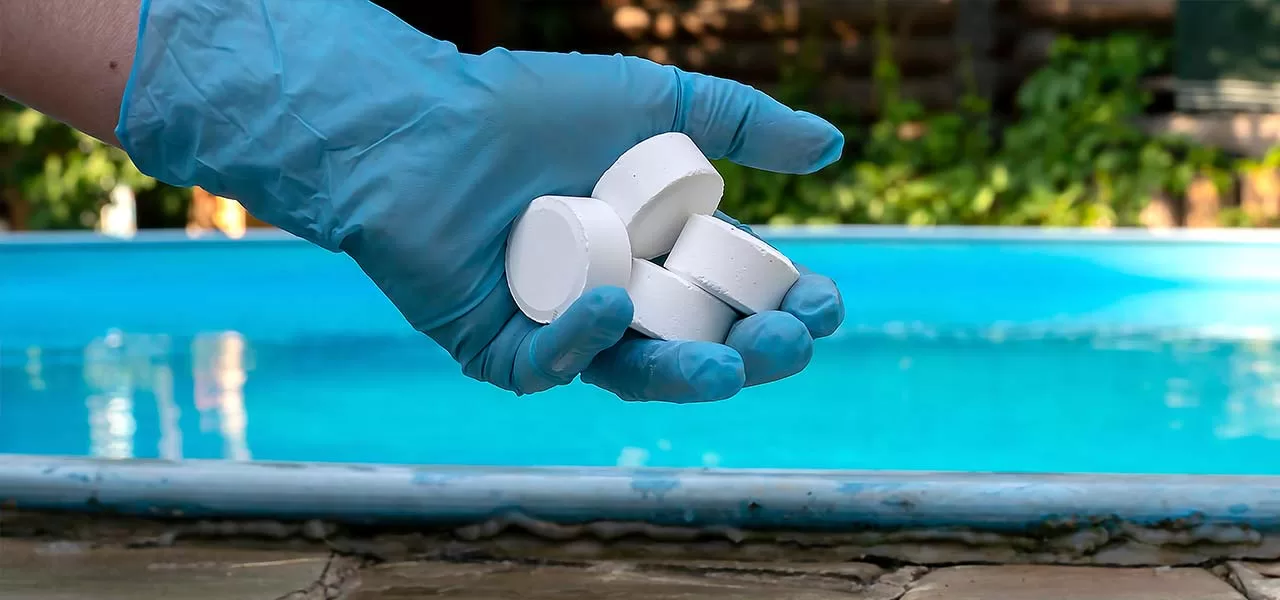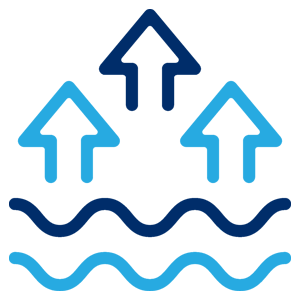FREE Standard Shipping On All Orders $100 or More!*

How to Reduce Pool or Spa Chlorine Levels
Maintaining the correct chlorine level can be tricky. And when super-chlorinating or shocking the pool to remove algae, bacteria, and chloramines from the water, it's very easy to overshoot the mark and over-chlorinate the pool.
Ideal pool chlorine levels are generally in the range of 2.0-4.0 parts per million (ppm). If your pool water is much higher than 4.0-5.0 ppm, keep reading to learn what you can do about it.
Why is My Chlorine Level So High?
Adding too much pool shock or putting too many chlorine tablets to the feeder can both result in very high levels of chlorine. Another common way to over-chlorinate a pool is to leave a liquid chlorine pump running all night – you'll often come in the next day to discover a greenish-looking pool.

Correct levels of chlorine stabilizer (Cyanuric Acid or CYA) will protect chlorine from the sun, and will slow the natural degradation of chlorine. CYA should stay in the ideal range of 30-50 ppm. If you find yourself having to add more stabilizer to the pool, slightly reduce the amount of chlorine used after application. Otherwise, you may find yourself accidentally adding way too much chlorine to the pool. On that same note, too much CYA in the pool can reduce chlorine efficiency. You may even get an inaccurate chlorine reading. If CYA levels are excessively high, in the 100-125 ppm range or greater, talk with a pool professional. You may need to consider diluting the water to bring levels back down.
Different times of year require different amounts of chlorine or bromine. On hot and sunny days, your pool will use up chlorine more quickly. The same holds true for pools with more swimmers and heavier leaf debris – you'll need more chlorine to maintain a consistent level of sanitation. On the other hand, swimming pools with efficient filtration and circulation systems, or pools with secondary sanitizers like minerals, ozonators, or UV systems, may require 50% less chlorine to maintain clean and clear water.
How High is Too High for Chlorine?

Every person's sensitivity to chlorine is different. When free chlorine is over 5.0 ppm, swimmers may experience itchy skin, irritated eyes, and/or dry hair.
Pools will naturally gas-off chlorine from the surface, and very high levels can irritate airways and lungs. This is especially true for indoor pools.
At chlorine levels over 10 ppm, swimsuits can begin to fade. Pool covers become damaged, and the water is generally uncomfortable and unsafe for swimmers. Close the pool and keep covers off until chlorine levels fall back below 5.0 ppm.
Testing Very High Chlorine Levels
When testing very high levels of chlorine, 10 ppm is the maximum detected by kits or strips. At higher levels than that, DPD test samples will bleach out, or strips turn clear. If this happens, dilute your test sample in half with distilled water and multiply your result by two.
For example, shake out half of the water test vial and refill with distilled water. Next multiply your test result x 2 to test for readings above 10 ppm. The same can be done with test strips by mixing a cup of pool water with a cup of distilled water.
How To Reduce Chlorine Levels in the Pool
First things first, if chlorine levels are too high, stop adding chlorine! Turn off your automatic chlorinator or remove your chlorine floater from the pool. There are a few different ways to lower the chlorine levels in your pool:
- Remove chlorine naturally with sunlight, aeration, and agitation of the water.
- Add Sodium Thiosulfate, a.k.a. Chlorine Neutralizer, for instant reduction.
- Add Ascorbic Acid, a.k.a. Vitamin C, to remove chlorine.
- Add Hydrogen Peroxide to break down chlorine.
The least expensive option is to allow the chlorine to dissipate naturally. After shocking the pool, leave the water uncovered, and allow the chlorine time to gas off on its own. Aerating the pool and circulating or agitating the water will help excess chlorine dissipate more quickly. But if you've accidentally added too much chlorine shock, and you need to use the pool sooner than later, there are a few other methods will help get you back in the pool faster. Pools located in shady areas may not be able to use this method reliably since it's largely dependent on direct sunlight.
When using Sodium Thiosulfate, add 2 oz. per 10,000 gallons of pool water to lower chlorine levels by 1.0 ppm. If using chemical methods to reduce chlorine levels, this one is probably the cheapest and most reliable method.
Ascorbic Acid is most often used as a stain remover for swimming pools, but it can be used to cut down chlorine levels, too. A 10 oz. dose per 10,000 gallons of pool water will lower chlorine levels by about 3.0 ppm.
Hydrogen Peroxide helps to break down chlorine, but works best in pH levels of 7.0 or higher. Use 7 oz. of Aqua Silk Oxidizer (27% hydrogen peroxide formula) per 10,000 gallons of pool water to lower chlorine level by 3.0 ppm. For spas and smaller bodies of water, use 1 oz. of 3% drug store grade hydrogen peroxide per 100 gallons of spa water to lower chlorine (or bromine) levels by about 5 ppm. Remember that pH levels will drop after an effective hydrogen peroxide treatment. Be sure to rebalance your water when done.
When using chemical methods to lower chlorine levels in pools and spas, be careful not to overshoot the mark. Overdosing the pool with Sodium Thiosulfate may make it difficult to add new chlorine, at least temporarily. Sodium Thiosulfate will dissipate from most pools within a few days. Always refer to the product label for recommended water balance and correct dosage instructions.
Reducing High Chlorine (or Bromine) in Hot Tubs
The methods for reducing sanitizer levels in spas and hot tubs are much the same as the ones listed above. In many cases, just leaving a hot tub uncovered and running the jet pump on high with the air blower running can bring high levels down in just a few hours.
If this doesn't work quickly enough, invest in a small bottle of Chlorine Neutralizer, which is also a very effective bromine reducer or neutralizer.
Remember that spas and hot tubs that use bromine can use higher levels of bromine with less side effects than chlorine. Bromine is 2.5x heavier than chlorine, meaning that a reading of 2.5 ppm bromine is the same as 1.0 ppm of chlorine. Most hot tubs using bromine should maintain a 3.0-5.0 ppm residual, or 1.0-3.0 ppm if using mineral sanitizers or ozone.
How high is too high for hot tub bromine? Sensitivity differs by person, but most folks can manage short duration soaks in hot tubs with bromine levels of up to 10 ppm (or chlorine levels of 5 ppm), without significant skin irritation. However, high bromine levels also leave a strong odor on skin and hair. This alone may be enough to prompt you to lower the levels.
Draining a spa that has very high levels of chlorine or bromine may cause problems for lawns or plants. Pumping it into a swimming pool (chlorine only), or directly to a storm drain are two other options. You can also dilute the water by partially draining and refilling the spa or hot tub.
To keep this issue from happening again, it often requires a change in your pool or spa management protocol. Extended periods of high chlorine or bromine levels can be detrimental to the health of your pool, equipment, and accessories like covers and floats. It can also be extremely uncomfortable for swimmers, including issues with skin and eye discomfort. Keep your water properly balanced, read and follow chemical label instructions, and understand the correct dosage measurements based on the size of your pool or spa.